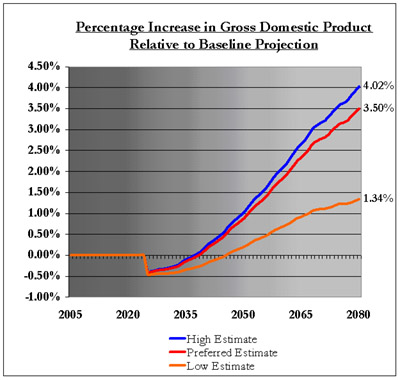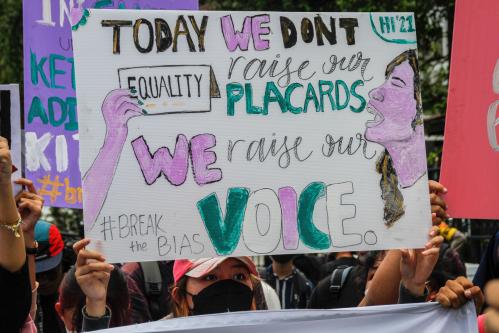Abstract ![]()
Many in Congress and the administration have called for new investments in education in order to make the United States more competitive, with President Bush stressing the importance of education in preparing young Americans to “fill the jobs of the 21st century.” Yet advocates of early childhood education have only recently stressed the economic benefits of preschool programs, and it has been difficult to win support for these short-term investments given the long-term nature of the benefits to the economy.
This policy brief analyzes the impact of a high-quality universal preschool policy on economic growth, concluding that such a policy could add $2 trillion to annual U.S. GDP by 2080. By 2080, a national program would cost the federal government approximately $59 billion, but generate enough additional growth in federal revenue to cover the costs of the program several times over.
Policy Brief # 153
Economists have long believed that investments in education, or “human capital,” are an important source of economic growth. Over the last 40 years output has risen about 3.5 percent a year. Growth in the productivity of labor, the major driver of increases in wages and standards of living, has measured about 2.4 percent per year. The contribution of education to labor productivity growth is estimated in different studies to be between 13 and 30 percent of the total increase. Whatever the contribution of education to growth in the past, investments in human capital may rise in importance relative to investments in other forms of capital as we transition to a post-industrial, knowledge-based economy.
Why might a more highly-educated work force increase economic growth? A more educated labor force is more mobile and adaptable, can learn new tasks and new skills more easily, can use a wider range of technologies and sophisticated equipment (including newly emerging ones), and is more creative in thinking about how to improve the management of work. All of these attributes not only make a more highly skilled worker more productive than a less skilled one but also enable employers to organize their work places differently and adjust better to changes necessitated by competition-by technical advances or by changes in consumer demand.
Just as a firm with better educated workers can perform better in these dimensions, so too can an economy with a better educated workforce. Skills beget more skills and new ways of doing business, workers learn from one another, and firms adapt their technology and their use of capital to the skills of the available work force. The benefits of having a more educated work force accrue to everyone, not just to the organization where these individuals happen to work. Further, these kinds of indirect (or spillover) effects for the firm or the economy as a whole may be especially important in an increasingly competitive global marketplace. Imagine an economy lacking in people able to read directions, use a sophisticated copier or a computer, or understand prevailing norms of behavior. Even if a single organization in that economy were able to find or import such skills, other organizations would not be able to invest in certain kinds of equipment or certain kinds of businesses with any assurance that it could make the investment profitable. Beyond that, a more educated work force may produce a less crime-ridden and healthier environment with better functioning civil institutions and all the benefits that flow to the business sector from that environment.
Past Work on Education and Growth
In 1957, Nobel Laureate Robert Solow described the growth of national income as having three sources: increases in the stock of physical capital (machines and buildings that are used to produce goods and services), increases in the size of the labor force, and a residual representing all other factors. This residual contributed considerably more to per capita growth than the increase in the capital stock. Solow dubbed the residual “technical progress” and noted that increasing levels of education were one of the factors that contributed to its growth. Using the same basic approach as Solow, but explicitly accounting for the role of education, Edward Denison estimated that between 1929 and 1982, increasing levels of education were the source of 16 percent of the growth of total potential output in the nonresidential business sector (and 30 percent of the growth in the productivity of people employed in that sector). A more recent study by Dale Jorgenson and Kevin Stiroh puts the contribution of education to economic growth at 8.7 percent of total growth over the period 1959 to 1998 and 13 percent of growth in output per worker.
Over the last two decades more attention has been paid to the theory of how education might affect economic growth and this work has implications for how we might model the impact of increased educational attainment. The “neoclassical” or “exogenous growth” studies described above assume that the immediate impact of increasing the amount of education per worker by 10 percent would be to increase GDP by only about 4 to 5 percent. Also, in the type of model used in those studies an increase in the rate of investment leads to an increase in the level of GDP, but in the long run has no effect on the rate of growth of GDP. More recent research using models where growth is endogenous suggests that both the direct and indirect effects of education on growth could be substantially larger. In some of these models the direct impact of a 10 percent increase in the amount of education that people get could be as much as 7 or 8 percent, and an increase in the rate of investment in education could produce a permanent increase in the rate of growth.
Prominent economists, including two recent chairmen of the President’s Council of Economic Advisers, hold sharply divergent views on the validity of these different models of economic growth. In order to proceed with our analysis without wading into this largely unsettled debate, we develop a single model that allows a broad range of assumptions about the importance of education for economic growth.
The Effects of Preschool Enrollment on Later Educational Attainment
We first estimate the effects of a specific preschool policy intervention on educational attainment and then analyze the effects of that additional education on economic growth relative to the projected growth path in the absence of the policy. In the particular simulation reported in this policy brief, we analyze the growth effects expected from a high-quality, national preschool program for all three- and four-year-old children. The best evidence about the effects of such an intervention on educational attainment comes from a set of small-scale experimental programs that featured random assignment and longitudinal evaluation of study participants. For this simulation, we use results from studies of the Perry Preschool Program, which delivered a high-quality program to a small group of disadvantaged children in Ypsilanti, Michigan in the 1960s, to determine the magnitude of the effect of high-quality preschool. We then adjust these results for the probable attenuation associated with delivering the program to a much broader and less disadvantaged group of children.
The Perry Preschool program provided low-income three- and four-year-old children with center-based care, two-and-a-half hours per day, five days per week for thirty weeks each year. The center-based care was supplemented on a weekly basis with one-and-a-half hour home visits by the child’s instructor. The Perry program was characterized by high instructor quality, as well as remarkably low student-teacher ratios. Study participants were selected on the basis of their low socioeconomic status (SES). In order to assess the effects of the program, program participants were randomly selected from a larger group of qualified children and the experiences of both those who took part in the program and those who did not were monitored on a periodic basis until the present-day, with study participants most recently surveyed at the age of forty.
At age twenty-seven, participants in the program were found to have levels of educational attainment 0.9 years greater than non-participants. We utilize this finding as the primary input to our economic growth model. It’s worth noting, however, that this difference in educational attainment likely understates the productivity improvements of program children, who also experienced gains in non-cognitive characteristics, including persistence and diligence. Also these narrow economic benefits were supplemented by numerous other benefits, including reduced rates of teenage pregnancy and dramatically lower rates of criminal activity relative to children who did not receive the program.
Projecting the effects of implementing a small scale program like Perry on a national level requires a number of assumptions in addition to the impact of the program on those who take part. First, a universal preschool program, if not compulsory, will not serve the full set of eligible children. Second, many of the children potentially served by this new policy initiative may already be enrolled in existing preschool programs, whereas most of children in the no-program group evaluated in the Perry study did not receive any early childhood education. Presumably, the impact of the program will be smaller for these children. Third, universal preschool programs will serve children that are less disadvantaged than those in the Perry Preschool experiment. It is not clear whether students with higher SES will experience comparable gains in educational attainment. Finally, preschool administrators may experience considerable difficulty in maintaining an equally high level of program quality in a program enrolling millions, rather than dozens, of children.
Based on experiences in Oklahoma and Georgia, scholars at RAND estimated that participation in a high-quality, voluntary, universal public preschool program would reach 70 percent of eligible children. Currently, 52 percent of three- and four-year-olds are already enrolled in preschool of some kind. Of those children who are already enrolled in preschool, roughly half are enrolled in public programs and half are enrolled in private programs. We assume that out of every 100 children, 70 will enroll in the proposed Perry-type program. These 70 children will be comprised of all of the children previously enrolled in public programs, approximately half of the children previously enrolled in private programs, and 60 percent of the children previously not enrolled in any preschool program.
We assume that children who would not have attended any preschool in the absence of this universal program now reap 100 percent of the benefits estimated for Perry (the full 0.9 year gain in educational attainment). We also assume that children who attended public preschool programs in the absence of this policy initiative will receive 50 percent of the effect, as the new initiative should be higher in quality than the average public program. For example, only 20 of the 38 states that provide any public preschool require lead teachers to hold a baccalaureate degree, whereas our proposed program requires all lead teachers in all states to possess such credentials. Finally, we assume that children previously enrolled in private preschool programs receive no additional educational benefit.
With regard to the possibility of differential program effects on children from more and less advantaged households, we turn to evidence from Oklahoma’s universal preschool program, which has recently been subjected to a quasi-experimental evaluation. That study, by William T. Gormley Jr., and others, found strong (and nearly comparable) gains across all income classes (though the children studied were still very young). These results indicate that children from both low and high income families may receive roughly comparable educational gains from participation in high-quality preschool programs. Similar findings have recently been reported in a study by W. Steven Barnett, Cynthia Lamy, and Kwanghee Jung at the National Institute for Early Education Research that evaluated preschool programs in Michigan, New Jersey, Oklahoma, South Carolina, and West Virginia.
In light of this evidence, we did not believe that it was necessary to reduce the effects further. Moreover, since nearly 20 percent of children under age six live in families below the poverty line, many of the remaining children who newly enroll in the universal program could conservatively be categorized as “at risk.” Under these assumptions, we calculate that the average increase in educational attainment for all children due to the preschool program will be 0.36 years.
How Educational Attainment Affects Economic Growth
The model tracks the number of years of education attained by each birth cohort and increases it for cohorts that received the preschool program. Take as an example a preschool program that covers half the population and causes people who attend to get an additional half year of education. This would cause an increase of a quarter of a year in the education of those in the first cohort to receive the program. However, for the first thirteen to fourteen years the program has no effect on growth as the first cohort of students who received the program are moving through elementary and secondary school. Eventually, there is an increase in the number of years of education these students obtain, which has two effects. First, since they are staying in school longer this reduces the size of the labor force and has a temporarily negative impact on output. However, once these students graduate their additional schooling enhances their productivity, yielding a positive impact on output. As time passes, and more students who have been in the preschool program graduate, the impact of the program on the size of the labor force remains roughly the same but the impact on the productivity of the workforce grows as larger fractions of the population receive the extra education. The direct effects continue to rise until the first cohort to receive the preschool education reaches retirement age.
These direct effects of increased education on output are augmented by the fact that some of the increased income generated by increased growth is reinvested in both physical and human capital. These dynamic feedback effects on physical and human capital accumulation go on year after year with the persistence of the growth effects depending on the assumptions made about the immediate impact of human capital on GDP.
Results
As discussed previously, the current state of macroeconomic research does not allow us to pin down a single value for the impact of education on GDP. Instead we test three different values spanning what we consider to be the plausible range. We label these “High Estimate,” “Low Estimate,” and “Preferred Estimate.” Our preferred estimate is not an intermediate value, but one conforming to the assumptions made in the particular growth model that we find most compelling.
Figure 1 displays the year-by-year predictions for all three impact assumptions relative to what economic growth would have been without the preschool program over a 75-year time horizon. The baseline per capita growth assumptions are drawn from the 75-year projections of the Social Security Trustees. To estimate growth effects we must make numerous assumptions about the growth process. To choose our preferred assumptions, we turn mainly to historical averages. In particular, we rely heavily upon data from the National Income and Product Accounts of the Bureau of Economic Analysis and the March Current Population Surveys reported by the Bureau of Labor Statistics.
The first effect of the policy initiative is to reduce the supply of labor when the first participants reach the age at which they would normally enter the labor force but instead extend the time they spend in school. This effect begins in 2025. However, when they enter the work force, they are more productive due to the additional education and that has a positive effect on output. By 2046, under all three assumptions, the positive effects start to outweigh the negative effects. At the high end, the effects turn positive as early as 2038. From here, the effects rapidly increase in magnitude, as additional treated cohorts enter the labor force and increased economic growth starts to result in positive dynamic feedbacks.
Table 1 reports estimates of the effect of the program on GDP for the 45-, 60-, and 75-year time horizon. Under the preferred estimate, by 2080, GDP increases by 3.50 percent, or 2,034 billion 2005 dollars, producing an extra $7,699 per capita.
These findings are robust to a wide range of reasonable values for key assumptions. While we conduct a full battery of sensitivity analyses, we find that the conclusions of the model are most heavily influenced by two key factors. First, the model is keenly sensitive to assumptions about the program’s take-up rate and the additional benefits received by those already receiving some form of preschool education, as well as any attenuation of effects associated with moving from a small and targeted program to one that serves all three- and four-year olds.
In addition, the results are also highly sensitive to the expected rate of return on education. It is possible that we have overestimated this return if employers not only value the knowledge people obtain in school, but also utilize educational credentials to identify individuals with high innate levels of ability. Concurrently, however, it is possible that we have underestimated the return to an investment in preschool in that we have not included the productivity gains for those Perry Preschool participants whose educational attainment was unaffected, but who nonetheless were more successful in the labor market as measured by their higher earnings.
Conclusion
The model predicts substantial gains in GDP, and in the stocks of physical and human capital, across a wide range of assumptions about the growth process. With our preferred assumptions, we predict an increase in GDP in 2080 of over $2 trillion (2005 dollars)-an increase of about 3.5 percent. Further, we must emphasize that these growth effects are all in addition to the well documented social benefits of early education programs.
To put these gains in perspective consider that federal revenue is likely to increase by about 20 percent of the total increase in GDP, or by about $400 billion (.20 x $2 trillion). We estimate that in 2080 the net cost of the program to the federal government will be $59 billion for a net fiscal surplus of $341 billion. At the same time, there are substantial costs that must be paid in the first few decades of the program and in this first report on our project, we have not attempted to determine the net benefits from the additional growth caused by this policy initiative. However, such estimates, along with other extensions of the model, are feasible. If we are underinvesting in education for some fraction of our population now, additional net benefits could be achieved by increasing the amount of education people get. This is more likely to be the case to the extent that spillover (or external) effects of education are important and to the extent that individuals fail, for various reasons (lack of financial liquidity, short-sightedness), to make investments for their children whose benefits accrue over the longer-run.
Because most of these benefits are longer-term while the costs of mounting the programs are more immediate, the political system tends to be biased against making such investments. However, any business that operated in this way would likely fail to succeed. A similarly dim prospect may be in store for a country that fails to take advantage of such solid investment opportunities.
Table 1. Effects of Universal Preschool for Three- and Four-Year-Olds On Gross Domestic Product (GDP)
|
Low Estimate |
||
|
|
% Increase in GDP |
Dollar Increase in GDP (2005 dollars) |
|
2050 |
0.20% |
$62 billion |
|
2065 |
0.92% |
$391 billion |
|
2080 |
1.34% |
$778 billion |
|
Preferred Estimate |
||
|
|
% Increase in GDP |
Dollar Increase in GDP (2005 dollars) |
|
2050 |
0.88% |
$270 billion |
|
2065 |
2.34% |
$988 billion |
|
2080 |
3.50% |
$2,034 billion |
|
High Estimate |
||
|
|
% Increase in GDP |
Dollar Increase in GDP (2005 dollars) |
|
2050 |
1.02% |
$314 billion |
|
2065 |
2.65% |
$1,123 billion |
|
2080 |
4.02% |
$2,340 billion |
Figure 1. Effects of Universal Preschool for Three- and Four-Year-Olds On Gross Domestic Product (GDP)

This work was funded by the National Institute for Early Education Research with a grant from The Pew Charitable Trusts – Advancing Quality Pre-Kindergarten for All.
See related paper: The Effects of Investing in Early Education on Economic Growth
The Brookings Institution is committed to quality, independence, and impact.
We are supported by a diverse array of funders. In line with our values and policies, each Brookings publication represents the sole views of its author(s).




